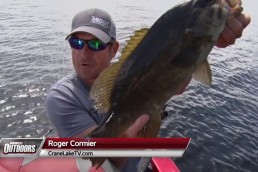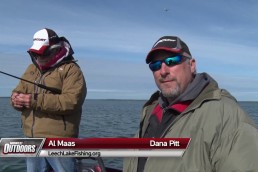On an Adventure for a Bounty of Whitefish
SHARE THIS POST
Lake Whitefish, commonly called whitefish, are a well sought-after species through the ice. With their long, thin body they can actually put up a decent fight, making catching one a pretty fun experience, especially on light tackle. Not only are they fun to catch, but they also are actually one of the major species of commercial fisheries in the Great Lakes and inland lakes of the U.S. and Canada.
The fact is, many enjoy them baked, filleted, battered and deep-fried and especially, smoked. Although they are not on the radar of most anglers, they probably ought to be, as they inhabit so many of the great fisheries we already enjoy. They also tend to school-up, so in most cases, if you catch one, you stand to catch more.
Whitefish look very similar in appearance to cisco (tullibee), and tend to frequent the same waters and areas. Many anglers have a difficult time telling the difference between the two. Each species are members of the trout and salmon family because of their body shape and the unique adipose fin on their back. The easiest way to distinguish between the two is their head and mouth. The head (or upper jaw) of a whitefish extends beyond the lower jaw. Conversely, the lower jaw of the tullibee extends to or beyond the upper jaw.
Most literature suggests that an average adult whitefish is around 4 pounds, with the upper end being at 5 pounds. The Minnesota state record is a 28.5-inch, 12-pound, 4-ounce specimen caught out of Leech Lake in 1999. The state record tullibee is a 5-pound, 11.8-ounce specimen caught out of St. Louis County.
Whitefish are a coldwater fish. During most of the year, this keeps them roaming the depths. And although during the winter cold water can be found everywhere, whitefish still tend to stick mostly to the depths. I have seen plenty of whitefish in the ultra-shallows, but it is almost always adjacent to deeper water and most of them are by themselves. Through the ice it can be a bit of an adventure to find them, but well worth the effort once you do.
Are you enjoying this post?
You can be among the first to get the latest info on where to go, what to use and how to use it!
Not every lake is the same, and this fish’s general location can vary depending on water condition and food sources. A great place to start the search is to fire up your auger and drill a few holes loosely associated with deep points and edges on the main lake and also in the middle of nowhere over the basins. Think and go to where the major water is on the system. For extremely large basins, it may be like finding a needle in the haystack so just make major adjustments before you try to dial them in. It takes more time, but the major basins typically have the mother lode in them. Smaller, deeper basins make it easier to adjust to find them.
Having electronics is extremely important, as they can be suspended 30 feet down over 70 feet of water. You will be simply lost without having an idea of where to present your bait. My Vexilar FLX-28 is always with me. One trick that some anglers do is to tilt the transducer a bit to try to get outside the normal cone in attempt to locate whitefish just out of the normal range of the transducer. You have to be careful, as the signal needs to be able to bounce back in order to be useful. Aiming the transducer horizontally in the water column may show nothing at all. Some anglers have brought out their summer units that have side imaging to aid in the search as well. Having friends and family help in the search will always speed up the search process.
These fish can put up a great fight, especially on light line. Using ultralight setups will get you hooting and hollering. This is a perfect application for fluorocarbon line such as Sufix Ice Flourocarbon. Most of the time you will need to get into the depths and 3- to 5-pound-test should be plenty. Whitefish and tullibee have relatively small mouths, so it helps to match your presentation accordingly. Smaller jigs and spoons adorned with waxworms is all that you will need. I prefer smaller dense spoons like the Buck Shot Rattle Spoon to be able to quickly get down to them. Sometimes it really helps to make a dropper setup off the Rattle Spoon. On the dropper line, add a small jig or plain hook and skewer on a few waxworms. Use the spoon as an attractor and seal the deal with the tiny offering below it.
If your staple fish you pursue through the ice has you dreaming of open water, then switch gears and try tackling whitefish and tullibee to refresh your love of fishing. You will be surprised at how fun it can be and how quickly they disappear off the dinner plate.
MWO
SHARE THIS POST
Did you enjoy this post?
You can be among the first to get the latest info on where to go, what to use and how to use it!
Steve Mattson
Steve Mattson has been writing articles for MidWest Outdoors since 2001. He is a driven angler, guide and sponsored tournament pro who has won both bass and panfish tournaments, and has placed in walleye and pike events. He resides in northern Minnesota and enjoys helping others catch more fish. For more info: mattsonangling.com and @mattsonangling.



